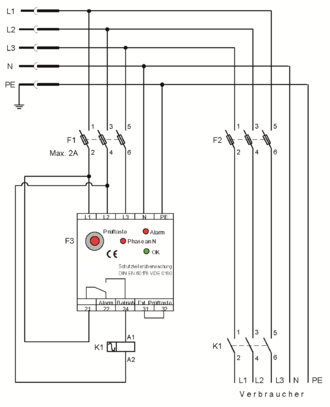Protective conductor monitoring
A protective conductor monitoring is in electrical installations for monitoring the protective conductor in single and three-phase systems with a mains frequency of 50 Hz or 60 Hz with or without neutral conductor used.
It determines the availability of the protective conductor by measurement and, if the measurement result is positive, actuates an integrated release relay . Only with this release is the voltage supply for the downstream consumers switched through via a contactor . The protective conductor monitoring is permanently in use. If the protective conductor is missing or if it is interrupted due to a cable break , the release will be refused or withdrawn at a later date.
use
Protective conductor monitoring is mainly used in mobile systems and devices. There, DIN EN 50178 / VDE 0160 stipulates that the leakage current (operational or non-operational) must not be greater than 3.5 mA . If the system or device has a higher value, the operator has several options. One possibility is to constantly check the presence of the protective conductor. Other possibilities would be e.g. B. a permanent connection or the laying of a second protective conductor (redundancy).
Electronic controls and frequency converters are often installed in mobile devices which, for reasons of electromagnetic compatibility, divert interference to earth. With these devices, a leakage current less than or equal to 3.5 mA can generally not be implemented.
Since options such as permanent connection or a second protective conductor rarely come into question in mobile devices, the use of protective conductor monitoring is the most suitable means here.
Normative background
Quote from DIN EN 50178 / VDE 0160
- Part 5.2.11.1 High leakage current
- "If electrical equipment (EB), when used as intended, has a permanently higher leakage current than AC 3.5 mA or DC 10 mA, a permanent connection is required for protection; this must be stated in the operating documents.
- The combination of a residual current protective device with, in particular, several EBs can be incompatible if the total leakage current from their high-frequency filters is so high that the residual current protective device is triggered.
- The total leakage current in the protective conductor can exceed AC 3.5 mA and DC 10 mA if several EB are connected to one supply source. In this case and if the protective conductor is interrupted, a person can be exposed to a leakage current that is higher than the limit of AC 3.5 mA or DC 10 mA. Under these conditions and as long as there are no international standards on measures to prevent this, the following must be carried out:
- Laying a second protective conductor or
- if the protective conductor is interrupted, the power supply is automatically switched off or
- the installation of a two-winding transformer (or equivalent equipment) in the power supply, the protective conductor of the circuit being connected to the bodies of the EB and the secondary winding of the transformer.
- Laying a second protective conductor or
- Measurement of the leakage current is required for EB that are not intended for permanent connection:
- The EB must be set up isolated without connecting the protective conductor and operated with rated voltage. Under these conditions, the current must be measured at the following points:
- a) for an EB that is intended for connection to a TN or TT network, between the protective conductor connection point and the protective conductor;
- b) in the case of an EB that is intended for connection to an IT network, between the protective conductor connection point and each outer conductor.
- The circuit must be designed in accordance with 5.1 of IEC 60990, Figure 3. "
- Part 5.3.2.1 Leakage current via the protective conductor
- "If a leakage current of AC 3.5 mA or DC 10 mA (eg caused by filters) is not exceeded or only exceeded in the event of failure of one or two star voltages of the supply network or in the event of a fault, no special measures are required. If the operational leakage current of AC 3.5 mA or DC 10 mA is exceeded with a permanently connected EB, one of the following conditions must be met:
- a) PE conductor cross-section at least 10 mm² copper;
- b) Monitoring of the protective conductor by a device which, in the event of a fault, leads to an automatic shutdown of the EB;
- c) Laying a second conductor, electrically parallel to the protective conductor, via separate terminals. This conductor alone must meet the requirements for protective conductors according to Section 543 of HD 384.5.54 S1. "
swell
- DIN EN 50178 / VDE 0160

